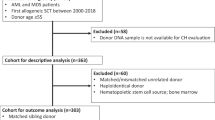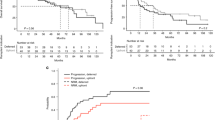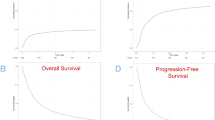Abstract
Relapse after allogeneic stem cell transplantation (allo-SCT) remains a major drawback of the procedure, occurring in approximately 30-60% of patients. While most relapses arise from the original malignant clone, they may also emerge from donor-derived cells harbouring genetic defects that confer a malignant phenotype. Although initially considered an exceedingly rare phenomenon, advances in molecular techniques for chimerism analysis have led to an increase in case reporting and awareness of donor-derived malignancy (DDM), with a rising estimated incidence. Differentiating between relapse of the original disease and DDM is critical, as they are associated with distinct treatment approaches and outcomes. In the case of DDM, there may also be significant ethical implications for the donor, with the dilemma of whether donors should be notified and whether high-risk donor populations – such as older individuals and those providing umbilical cord blood grafts – should be screened for germline mutations or clones of indeterminate potential prior to donation. Since the first report of a DDM case in 1971, 64 cases were reported through 2009. The aim of this study was to systematically review the literature and critically analyze the DDM cases reported from 2009 to 2024, identifying potential common characteristics that may predispose to DDM development.
This is a preview of subscription content, access via your institution
Access options
Subscribe to this journal
Receive 12 print issues and online access
$259.00 per year
only $21.58 per issue
Buy this article
- Purchase on SpringerLink
- Instant access to full article PDF
Prices may be subject to local taxes which are calculated during checkout




Similar content being viewed by others
Data availability
The data that support the findings of this study are available from the corresponding author upon reasonable request.
References
Copelan EA. Hematopoietic stem-cell transplantation. N Engl J Med. 2006;354:1813–26.
Kumar L. Leukemia: management of relapse after allogeneic bone marrow transplantation. J Clin Oncol. 1994;12:1710–7.
Myron Kauffman H, McBride MA, Cherikh WS, Spain PC, Marks WH, Roza AM. Transplant tumor registry: donor related malignancies. Transplantation. 2002;74:358–62.
Horowitz M, Schreiber H, Elder A, Heidenreich O, Vormoor J, Toffalori C, et al. Epidemiology and biology of relapse after stem cell transplantation. Bone Marrow Transpl. 2018;53:1379–89.
Giralt SA, Champlin RE. Leukemia relapse after allogeneic bone marrow transplantation: a review. Blood. 1994;84:3603–12.
Williams LS, Williams KM, Gillis N, Bolton K, Damm F, Deuitch NT, et al. Donor-derived malignancy and transplantation morbidity: risks of patient and donor genetics in allogeneic hematopoietic stem cell transplantation. Transplant Cell Ther. 2024;30:255–67.
Kato M, Yamashita T, Suzuki R, Matsumoto K, Nishimori H, Takahashi S, et al. Donor cell-derived hematological malignancy: a survey by the Japan Society for Hematopoietic Cell Transplantation. Leukemia. 2016;30:1742–5.
Hertenstein B, Hambach L, Bacigalupo A, Schmitz N, McCann S, Slavin S, et al. Development of leukemia in donor cells after allogeneic stem cell transplantation-a survey of the European Group for Blood and Marrow Transplantation (EBMT). Haematologica. 2005;90:969–75.
Wiseman DH. Donor cell leukemia: a review. Biol Blood Marrow Transpl. 2011;17:771–89.
Atsuta Y, Baldomero H, Neumann D, Sureda A, DeVos JD, Iida M, et al. Continuous and differential improvement in worldwide access to hematopoietic cell transplantation: activity has doubled in a decade with a notable increase in unrelated and non-identical related donors. Haematologica. 2024;109:3282–94.
Niederwieser D, Baldomero H, Bazuaye N, Bupp C, Chaudhri N, Corbacioglu S, et al. One and a half million hematopoietic stem cell transplants: continuous and differential improvement in worldwide access with the use of non-identical family donors. Haematologica. 2022;107:1045–53.
Tokaz MC, Baldomero H, Cowan AJ, Saber W, Greinix H, Koh MBC, et al. An Analysis of the Worldwide Utilization of Hematopoietic Stem Cell Transplantation for Acute Myeloid Leukemia. Transplant Cell Ther. 2023;29:279.e1–e10.
Penack O, Peczynski C, Mohty M, Yakoub-Agha I, Styczynski J, Montoto S, et al. How much has allogeneic stem cell transplant-related mortality improved since the 1980s? A retrospective analysis from the EBMT. Blood Adv. 2020;4:6283–90.
Gratwohl A, Pasquini MC, Aljurf M, Atsuta Y, Baldomero H, Foeken L, et al. One million haemopoietic stem-cell transplants: a retrospective observational study. Lancet Haematol. 2015;2:e91–100.
Zuanelli Brambilla C, Lobaugh SM, Ruiz JD, Dahi PB, Goldberg AD, Young JW, et al. Relapse after allogeneic stem cell transplantation of acute myelogenous leukemia and myelodysplastic syndrome and the importance of second cellular therapy. Transplant Cell Ther. 2021;27:771.e1–e10.
Socie G, Stone JV, Wingard JR, Weisdorf D, Henslee-Downey PJ, Bredeson C, et al. Long-term survival and late deaths after allogeneic bone marrow transplantation. Late Effects Working Committee of the International Bone Marrow Transplant Registry. N Engl J Med. 1999;341:14–21.
Bejanyan N, Weisdorf DJ, Logan BR, Wang HL, Devine SM, de Lima M, et al. Survival of patients with acute myeloid leukemia relapsing after allogeneic hematopoietic cell transplantation: a center for international blood and marrow transplant research study. Biol Blood Marrow Transpl. 2015;21:454–9.
Antier C, Jullien M, Tessoulin B, Loirat M, Peterlin P, Garnier A, et al. Late relapse after allogeneic stem cell transplantation in patients treated for acute myeloid leukemia: relapse incidence, characteristics, role of conditioning regimen, and outcome. Cancers. 2024;16:1419.
Engel N, Rovo A, Badoglio M, Labopin M, Basak GW, Beguin Y, et al. European experience and risk factor analysis of donor cell-derived leukaemias/MDS following haematopoietic cell transplantation. Leukemia. 2019;33:508–17.
Musiu P, Quattrocchi L, Barberi W, Della Starza I, Elia L, De Novi LA, et al. Donor cell derived mantle cell lymphoma in a HSCT sibling donor-recipient pair: intrinsic biological clock in lymphomagenesis. Leuk Lymphoma. 2022;63:499–502.
Otero L, de Souza DC, de Cassia Tavares R, Gomes BE, Padilha TF, Bouzas LF, et al. Monosomy 7 in donor cell-derived leukemia after bone marrow transplantation for severe aplastic anemia: Report of a new case and review of the literature. Genet Mol Biol. 2012;35:734–6.
Deshmukh KG, Kelemen K. Lessons learned from donor cell-derived myeloid neoplasms: report of three cases and review of the literature. Life. 2022;12:559.
Jaiswal S, Ebert BL. Clonal hematopoiesis in human aging and disease. Science. 2019;366:eaan4673.
Gibson CJ, Kim HT, Zhao L, Murdock HM, Hambley B, Ogata A, et al. Donor clonal hematopoiesis and recipient outcomes after transplantation. J Clin Oncol. 2022;40:189–201.
Kennedy AL, Shimamura A. Genetic predisposition to MDS: clinical features and clonal evolution. Blood. 2019;133:1071–85.
Halik A, Tilgner M, Silva P, Estrada N, Altwasser R, Jahn E, et al. Genomic characterization of AML with aberrations of chromosome 7: a multinational cohort of 519 patients. J Hematol Oncol. 2024;17:70.
Lindsley RC, Mar BG, Mazzola E, Grauman PV, Shareef S, Allen SL, et al. Acute myeloid leukemia ontogeny is defined by distinct somatic mutations. Blood. 2015;125:1367–76.
Marchionni L, Lobo FP, Kostadinov R, Serra A, Besso FG, Deaglio S, et al. Donor-derived acute myeloid leukemia in solid organ transplantation. Am J Transpl. 2022;22:3111–9.
Babushok DV, Bessler M, Olson TS. Genetic predisposition to myelodysplastic syndrome and acute myeloid leukemia in children and young adults. Leuk Lymphoma. 2016;57:520–36.
Suarez-Gonzalez J, Martinez-Laperche C, Kwon M, Balsalobre P, Carbonell D, Chicano M, et al. Donor Cell-Derived Hematologic neoplasms after hematopoietic stem cell transplantation: a systematic review. Biol Blood Marrow Transpl. 2018;24:1505–13.
Holyoake TL, Nicolini FE, Eaves CJ. Functional differences between transplantable human hematopoietic stem cells from fetal liver, cord blood, and adult marrow. Exp Hematol. 1999;27:1418–27.
Mori H, Colman SM, Xiao Z, Ford AM, Healy LE, Donaldson C, et al. Chromosome translocations and covert leukemic clones are generated during normal fetal development. Proc Natl Acad Sci USA. 2002;99:8242–7.
Greaves MF. Cord blood donor cell leukemia in recipients. Leukemia. 2006;20:1633–4.
Khattab A, Patruni S, Patrus G, Samhouri Y, Fazal S, Lister J. Donor cell leukemia following allogeneic hematopoietic stem cell transplantation. J Hematol. 2023;12:138–44.
Frick M, Chan W, Arends CM, Hablesreiter R, Halik A, Heuser M, et al. Role of donor clonal hematopoiesis in allogeneic hematopoietic stem-cell transplantation. J Clin Oncol. 2019;37:375–85.
Kato M. [Donor cell-derived hematological malignancies after allogeneic hematopoietic stem cell transplantation]. Rinsho Ketsueki. 2017;58:813–7.
Ogonek J, Kralj Juric M, Ghimire S, Varanasi PR, Holler E, Greinix H, et al. Immune reconstitution after allogeneic hematopoietic stem cell transplantation. Front Immunol. 2016;7:507.
Palka G, Calabrese G, Di Girolamo G, Stuppia L, Di Bartolomeo P, Guanciali Franchi P, et al. Cytogenetic survey of 31 patients treated with bone marrow transplantation for acute nonlymphocytic and acute lymphoblastic leukemias. Cancer Genet Cytogenet. 1991;51:223–33.
Aldoss I, Song JY, Curtin PT, Forman SJ. Multiple donor-derived leukemias in a recipient of allogeneic hematopoietic cell transplantation for myeloid malignancy. Blood Adv. 2020;4:4798–801.
Kurosawa S, Doki N, Hino Y, Sakaguchi M, Fukushima K, Shingai N, et al. Occurrence of donor cell-derived lymphoid blast crisis 24 years following related bone marrow transplantation for chronic myeloid leukemia. Intern Med. 2016;55:395–7.
Author information
Authors and Affiliations
Contributions
PT: Formal analysis and writing, IL: Conceptualization, analysis, and editing writing.
Corresponding author
Ethics declarations
Competing interests
The authors declare no competing interests.
Additional information
Publisher’s note Springer Nature remains neutral with regard to jurisdictional claims in published maps and institutional affiliations.
Supplementary information
Rights and permissions
Springer Nature or its licensor (e.g. a society or other partner) holds exclusive rights to this article under a publishing agreement with the author(s) or other rightsholder(s); author self-archiving of the accepted manuscript version of this article is solely governed by the terms of such publishing agreement and applicable law.
About this article
Cite this article
Tsirigotis, P., Lazana, I. Donor-derived malignancy after allogeneic stem cell transplantation: a rare but well recognized complication. Bone Marrow Transplant (2025). https://doi.org/10.1038/s41409-025-02725-9
Received:
Revised:
Accepted:
Published:
DOI: https://doi.org/10.1038/s41409-025-02725-9



